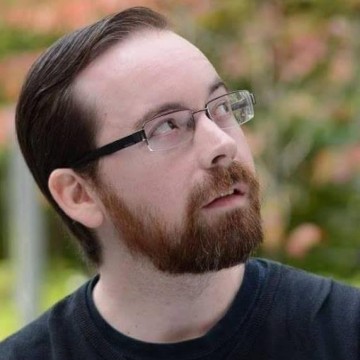An Interview with Indie Horror Filmmaker P.J. Starks: Part 1 – On Making Independent Horror, and Taking ‘New Fears Eve’ on the Road
“We’re in a packed theater in Chicago. Practically all strangers. Right out of the gate there’s an inappropriate joke.”
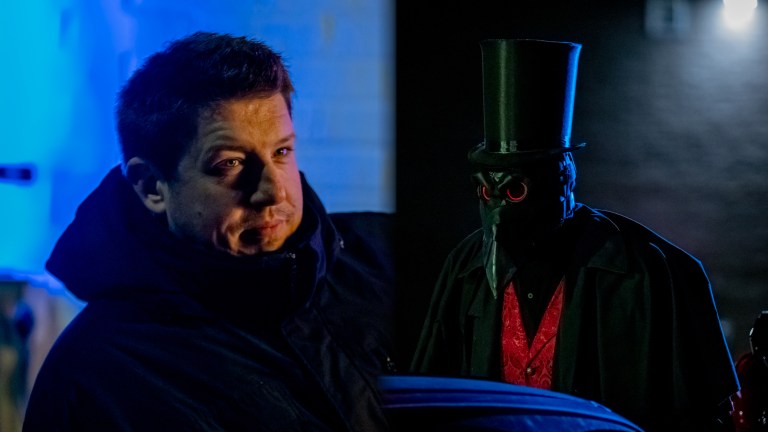
P.J. Starks is a writer, director, and producer who has been making independent films for two decades. He currently has multiple projects in various stages of production, and he kindly took the time to speak with us about his films and his filmmaking process.
We wanted to get in-depth with P.J., so our conversation is split into two part. In this first half of the interview, P.J. discusses his inspirations for getting into making movie, as well as his philosophies about directing and producing. He also shares the highs and lows of taking his most personal film, New Fears Eve, on the road and sharing it with audiences. Read on, and look out for part two of the interview later this coming Thursday when we talk about his newest projects: The Last Sleepover, The Barn Part III, and Half-O-Ween!
Creepy Catalog: It’s been about 18 years since you wrote and directed your first released film, Hallows Eve: Slaughter on Second Street. What inspired you to make your first movie and get into filmmaking?
P.J. Starks: Oh wow. It’s hard to believe it’s been that long. I’d been dabbling in indie filmmaking for a while prior to Hallows Eve. The first time I got any coverage was a feature length comedy called Second Shift in 2005, which was a quasi-romance with a lot of shit jokes and bodily fluid mishaps. It was full of fart and heart. I never sought distribution. I was young and very inexperienced, but the film does hold up in a lot of ways. I’ve considered maybe releasing it onto YouTube or Facebook. But it might get me cancelled, I don’t know. [laughs]
My passion for being a visual storyteller began in high school. I wrote a lot. I pretty much have unproduced scripts from every decade of my life. But going back to Hallows Eve, it was my first real foray into genre filmmaking, my true love, but it was still a comedy. It’s not a spoiler but if you watch the trailer, you’ll pick up immediately that the film is a homage to Scooby Doo. I went into the project asking, “what if Mystery Inc. got caught up in a murder mystery in real life?” I had a lot of fun making that film, but it also taught me I can’t do everything on my own.
CC: Do you have any favorite films, horror or otherwise, that you regularly watch for inspiration?
P.J.: I have a whole myriad of films that I love, from The Goonies to Ghostbusters, with the latter being the catalyst for my love of everything horror. I’m inspired by a lot of movies I watch in many ways. Visually I love a moving camera so I’m always on set saying something like, “we’re gonna Michael Bay this shit!” I think stylistically my movies are typically an amalgamation of many different types and genres.
Tonally I almost always inject comedy. I’ve been heavily influenced by Kevin Smith, with Clerks being the film that truly gave me the motivation to pursue filmmaking. Then I have films that I call my comfort food. They’re flicks I watch regularly like Hell Night, Madman, The Prowler, Friday the 13th Part 4, Shock Waves, The Beyond, Zombie, My Bloody Valentine, The Gates of Hell—the list goes on and on. I watch them pretty much every night. Just ask my wife [laughs].
CC: Making a career out of filmmaking is difficult. When you started out, did you see yourself thriving in the business nearly two decades later? Has the journey been like you hoped or expected?
P.J.: You’re absolutely correct. It’s very difficult. I’m all about transparency so I won’t pretend I’m Jason Blum of the Midwest—though, yes, someone did jokingly say that recently. I don’t refer to my art as a career. Not yet anyway. I’m far beyond aspiring, but it’s more of a professional hobby than an occupation. I do work a regular nine to five. I’m the Director of Technical Operations at a law firm and I’m incredibly fortunate to do what I love for a living. However, I’m still immersed in the daily grind of trying to create something in the hopes it captures lightning in a bottle like Terrifier 2.
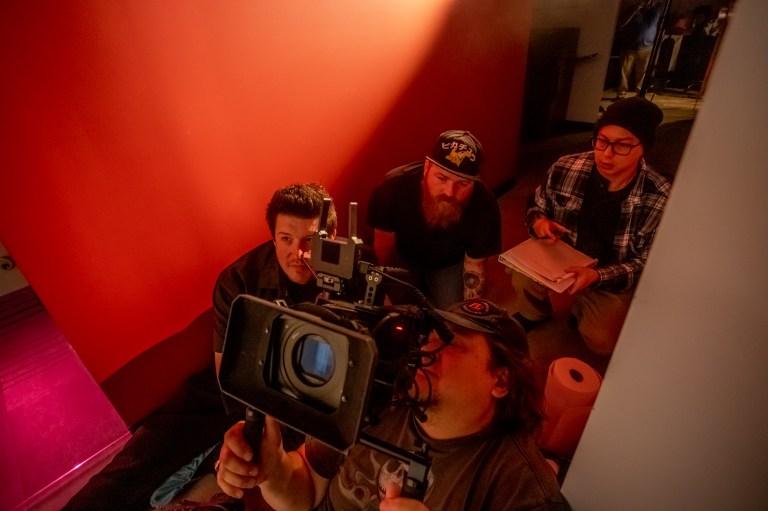
Like a lot of filmmakers, the original dream was to run off to NY or LA and be the next Spielberg, but often, it’s a pipe dream. I ended up following a different path but there’s no regrets. Because of where it’s taken me I’ve created some cool projects along the way; have met and in some cases became friends with industry actors and filmmakers I grew up watching or admiring; and have been able to collaborate with some insanely talented creatives that I now work with repeatedly. It’s been nothing like I expected—and I’m genuinely grateful for that. It led me to partner with Eric (Huskisson), who’s just as passionate as me, and I ultimately married Leslie, who’s the most amazing and supportive person I know.
CC: At this point you seem to be focusing more on producing. I understand you are producing nine movies currently in production, with five that you are actively working on. How do you manage such a workload?
P.J.: Like anything it’s all about time management. Especially when I live a normal life on top of the filmmaking. It also depends in what capacity I’m producing. I’m more heavily involved in some of the films than I am in others. With The Barn Part III and The Last Sleepover, for instance, I’ve been on these projects since the beginning. With TLS I gave notes on the script and overhauled the deaths which is also how I earned a writing credit. I have also been directly involved in helping secure financing. With TB3 I helped build the Indiegogo campaign, did graphic design, did some video on and edited the promotional video. Eric and I are both producers of this film and have helped in part with financing.
CC: How hands-on do you think a producer should be in the creative process of making a movie?
P.J.: It really depends on the circumstances. With New Fears Eve I had my hands in just about every single aspect from script to screen, but I also conceived the project, wrote the script, and co-directed the film. That doesn’t mean I was micro-managing the project. Everyone on set is creative. There needs to be a level of trust where you allow them to do their job. If something isn’t getting done or isn’t being done right, that is when a producer needs to step in. A good producer removes barriers and solves problems—often, that’s the real job. I believe, within reason, those who are managing departments and those in said departments need to have a level of creative freedom.
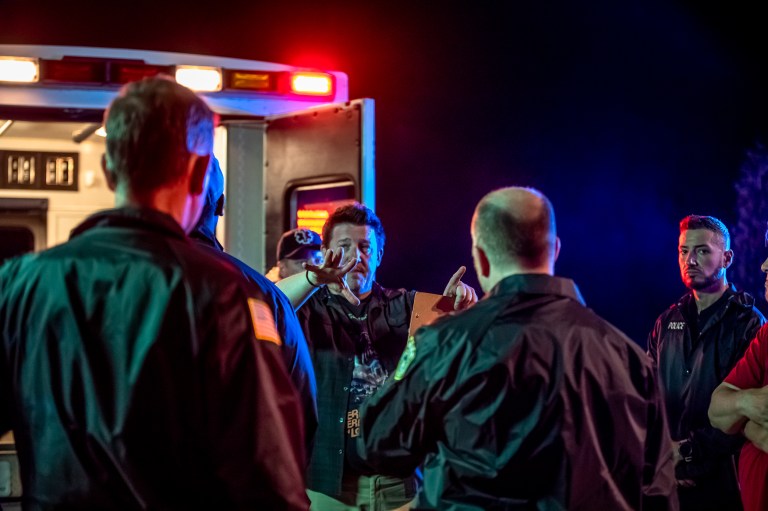
When it comes to producing other filmmakers’ visions, especially when it’s someone I haven’t worked with before, I do have a vetting process. Communication is very important to me, so I always talk extensively with them. Asking questions about the story, the overall project and what their plans are in the long run. I want to read the script to determine if it’s something I’m interested in. Is it fun? Does it tell an interesting story? Do I give two shits about the characters? Those things are important.
Lastly, collaboration is key. Are they open to ideas and suggestions? I’m not saying every idea I have is groundbreaking or that they even must use them, but are the filmmakers at least open to said ideas and willing to listen? Now that’s not to say every filmmaker I’ve worked with is like that because a lot of filmmakers are very different but, in my experience, the films that have been most successful had synergy.
CC: Which do you prefer: directing or producing?
P.J.: I would have to say producing. As similar as they are, they’re also different in a lot of ways. I produced but also co-directed New Fears Eve. I also produced and directed a segment in 13 Slays Till X-Mas, which just creates more stress. I’m a glutton for punishment I suppose. Producing gives me the option to be engaged with various departments and I like that. Networking is a big part of the creative process, therefore, by connecting with others and being able to give input can only strengthen the project. I’m also self-aware enough that if I give an idea that won’t work, I understand that too is part of the workflow.
CC: The biggest film of yours we’ve covered on Creepy Catalog is New Fears Eve. Personally, following its development over the past year has been a lot of fun. From theatrical screenings to festival and convention appearances, you’ve spent a lot of time with this movie. What have been some of the highlights of going on the road to promote New Fears Eve? Any interesting stories you could share?
P.J.: The film got into thirteen festivals. It was showcased from Houston to Cincinnati and even had a UK premiere. The very first public debut was in Chicago. Which was nerve racking in of itself, because watching a film with a group of strangers isn’t new to me, but mainly because this film is so deeply personal. Plus, this is the film that Eric and I are banking on taking us to the next level.
I don’t care who you are, you want people to enjoy your movie. I’ll back track and say that I grew up in the 80s and 90s, so I’ve got a pretty loose, dark sense of humor—way out of step with today’s norms. That’s my way of saying there’s risqué quips throughout the film. But before you judge too harshly—Jeffrey (Reddick) told me what sold him most on the film, outside the immediate likability of the characters, was my script’s willingness to embrace the kind of humor that today’s studios typically steer clear of. Think Office Space meets Scream with some set pieces akin to Porky’s or American Pie.
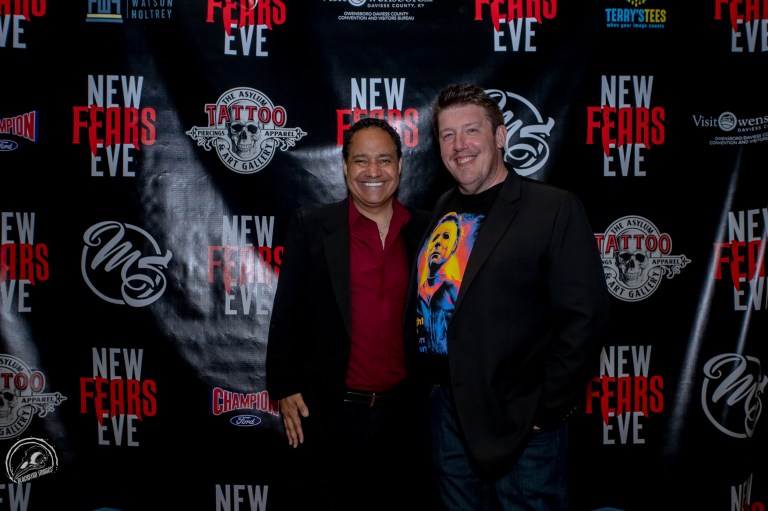
Anyway… We’re in a packed theater in Chicago. Practically all strangers. Right out of the gate there’s an inappropriate joke. No laughs. It seems the lines I barely think twice about are getting the biggest laughs. Then other moments in the film I think should make audience members cackle—silence. I’m not sure if you’ve ever experienced sitting in a room full of people, all dead silent, while someone on a giant screen mimics an orgasm—’awkward’ doesn’t even begin to describe it. The girl in front of us turned to the guy next to her and literally said, “uh, what the fuck are we watching?” Eric is sitting there next to me with his face in his hands. I was dying on the inside.
Now that’s not to say the film didn’t get laughs, it did. Some solid ones. But not as many I as I believed it should have. The film also has a lot of character building and serious dramatic moments. It’s not your typical slasher fare, so in those moments the audience is also silent because they’re taking in all the plot. Now, the forty plus elaborate death scenes got great pops from the crowd. There are even some kills in the film that made people cringe, squirm in their seats and groan with disgust, which was awesome.
The film ended, we did a brief Q&A and then I left to get some air. I was, in a word—devastated. I called Leslie, my girlfriend at the time, and she excitedly asked, “How’d it go?” I begrudgingly retorted, “It was terrible. Everyone hated the film. I’m never making another movie. I want to die. This is a nightmare.” Not a second after I hung up a group of people came over to tell me how hilarious the film was. They exclaimed New Fears Eve was the highlight of the festival and so on. It was like that for the rest of the event. Everyone we talked to had heard about how gory and funny the movie was and those who’d seen it raved about the special effects or how textured the story was.
It went on to win Best Horror Comedy at the festival. I was speechless if not thoroughly confused, but no less thankful. As a matter of fact, it won over 15 awards during the festival tour with four of those being Best Horror Comedy as well as an Audience Choice Award thanks to HorrorHound. NFE was even nominated for a Fangoria Chainsaw Award. Which fucking blew my mind. I grew up reading Fango, so the fanboy in me was on cloud nine.
I guess the moral here is when you’re intensely close to something it’s easy to have a level of expectations that can easily be crushed by the varied tastes of those experiencing it. Just because one joke didn’t work in Chicago, doesn’t mean it didn’t work in NYC or Indianapolis. The scene that got complete silence in Chicago ended up killing at other screenings. It all depends on who’s watching.
CC: What’s more rewarding for you: the process of making a movie, or seeing people’s reactions once it’s been completed?
P.J.: That’s a great question. Every aspect comes with its own headaches as well as sense of accomplishment. Seeing people’s reactions can be a lot of fun. Typically, by the time an audience sees your movie you’ve already watched it a dozen times or more throughout post-production. If anything, an audience being entertained by your film reinvigorates your passion for the project. But nothing can beat being on set, working directly with other artists from different walks of life with everyone striving towards the same goal.
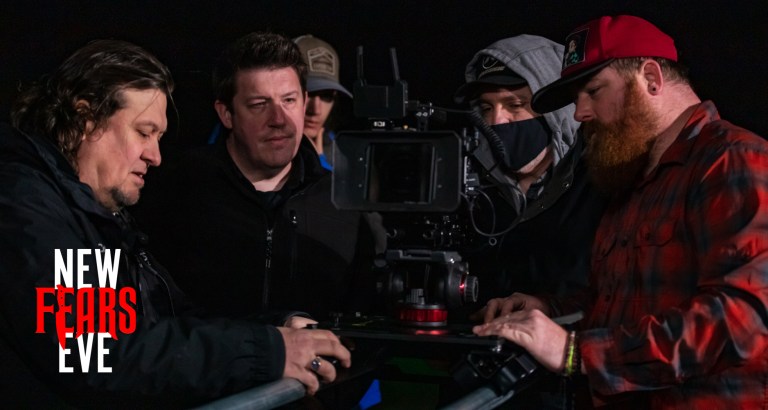
While I enjoy writing, I find writing a script can be tedious. I tend to be very lazy, but once I motivate myself to set the process in motion, I have a hard time quitting. Casting is a lot of fun. Especially in person auditions since you get to meet and interact with new talent. I enjoy choosing the best actors for the best parts. Location scouting can be monotonous, but it can inspire you when the right spot is discovered and, in some cases, you’ll find an aesthetic that wasn’t in your head but you’re able to rework the logistics enough to make it gel. Financing absolutely sucks. I hate every single moment of it. It’s stress inducing, time consuming, draining, and if it doesn’t go well can quickly tank the project. There’s so much more to pre-production, some drudging and some enjoyable. Department meetings, countless conference calls, emails, texts, and inevitably saying, “fuck, I thought we had that nailed down? How do we fix this?”
Once you get through all of that, you reach filming and, not to sound too hokey, that is where the magic truly happens. The script literally comes to life. The characters become flesh and blood people. Our film has a cool, stylized masker murderer portrayed by the very talented Jesse McDonald. The first time I saw him walk on set in full costume I almost cried he looked so badass. Essentially a good chunk of the vision comes together during production.
My two best times on set have been Volumes of Blood: Horror Stories and most recently with New Fears Eve. We had a solid cast and crew on NFE. You could without-a-doubt feel the comradery among everyone. It was an electric atmosphere. Everyone’s hard work and enthusiasm is displayed on screen. The script for NFE was so intimate I seriously cannot thank everyone enough for giving their time and talents. From our leads Lily-Claire, Matthew and Turner; our insanely talented DP Alex Clark; the special fx team Stephen, Isa, and Blaze who bloodied up the frames brilliantly; our stellar crew Steven, Ryan, Tim, Joshua, Orion, Brandon, Jess, Landon, Jackson, Shawna; Jeremy Mulligan for helping coordinate some of the large set-pieces; and ultimately Frank Dormani who gave the film its musical voice. The most satisfying element has been knowing all the challenges we faced, the grueling effort that went into so many scenes, and that our unyielding resolve to make something kickass paid off.
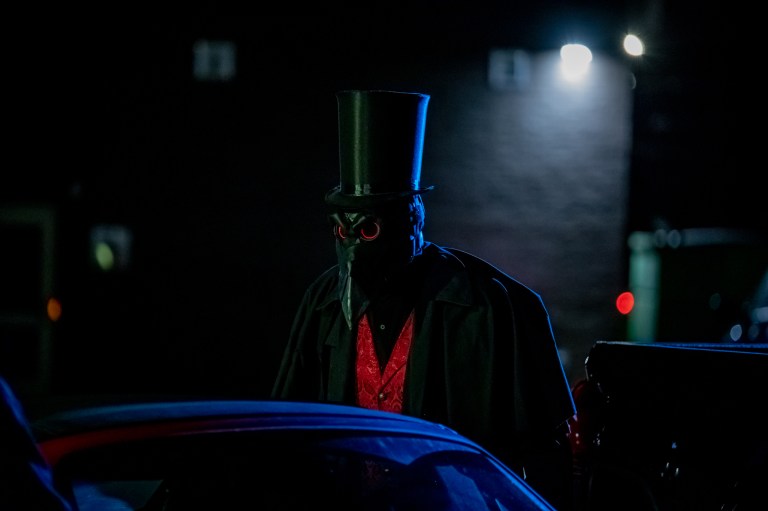
CC: Any updates on when we’ll see a distribution deal for New Fears Eve?
P.J.: We’re currently in serious talks with a reputable company. We’re confident that we’ll be making an announcement in the coming months.
Check back for part two of our interview with P.J. Starks on Thursday.
